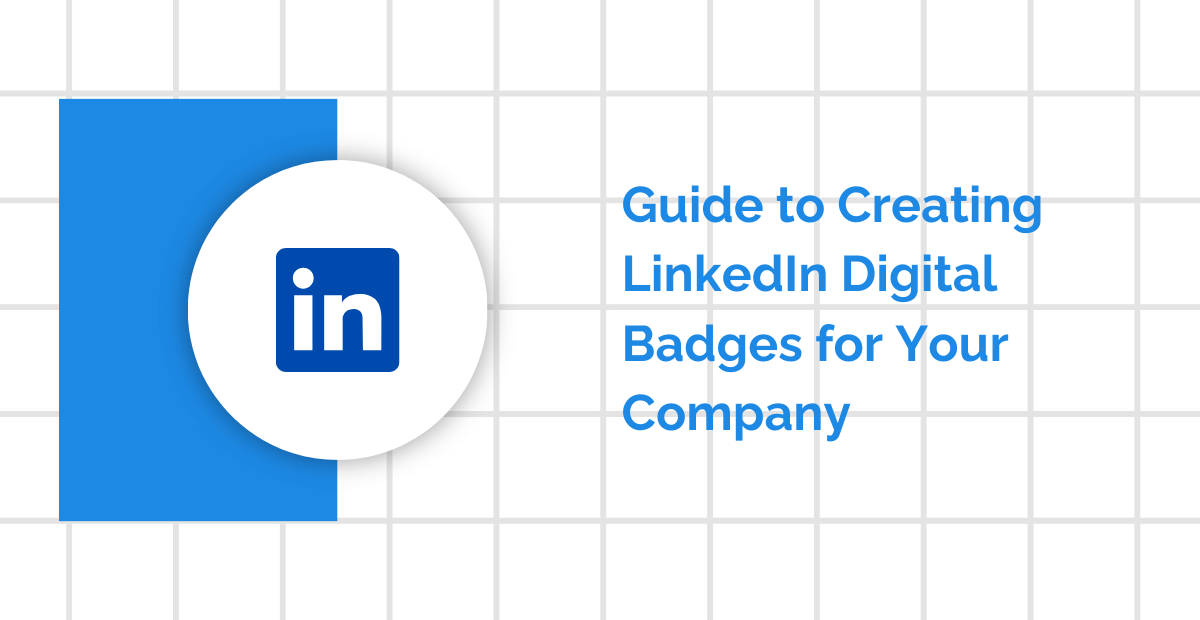Let’s say you’ve just completed a leadership workshop online. The moment you finish, an email drops in your inbox—it’s a digital badge. It looks like a colorful emblem with your name, the skills you gained, and where you earned it. Cool, right? But… What do you actually do with it?
At first glance, a digital badge might seem like just another participation trophy. But in reality, it’s much more. Digital badges are verifiable, shareable, and skill-based credentials that can help you keep track of your learning journey and showcase it in real life.
Think of them as smart certificates—easy to store, easy to show, and packed with proof of what you’ve actually learned. And when it comes to setting and reaching educational goals, these little badges pack a surprising punch.
In this blog, we’ll break it all down—from what badges are, to how they help both students and university staff stay organized, motivated, and aligned.
The Struggle is Real: Why Setting Educational Goals Isn’t Enough
We’ve all been there. Start of the semester, full of energy and promises.
-
“This term, I’ll keep up with my readings.”
-
“I’ll finally join that extracurricular club.”
-
“I’m going to build my resume while still in college.”
But then, life happens. Assignments pile up. Midterms sneak in. And your goals? They quietly take a back seat.
The problem isn’t the goals—it’s how we track them. Educational goals often remain vague or invisible. Students may complete courses and projects without realizing how each step adds up to something bigger. And for staff in registrar offices or advising centers, it can be tough to tell what a student’s broader learning journey actually looks like.
Badges help bring clarity. They make progress visible. They turn blurry goals into tangible milestones. Whether you’re the one learning or guiding the learners, that kind of clarity makes all the difference.
Enter Digital Badges: Tiny Symbols, Big Purpose
So, what exactly is a digital badge?
Let’s skip the technical mumbo-jumbo. A digital badge is like a digital version of a scout badge—but smarter.
It’s an image file embedded with data that proves:
-
What you learned (e.g., research methods)
-
Who issued it (e.g., your university)
-
When you earned it
-
How you proved your skills (maybe through a test or project)
It’s not just a pretty design. It’s evidence—packaged, shareable, and verifiable.
If you’re wondering how digital badges became portable and meaningful across different platforms, take a look at what defines a digital open badge—it explains why openness makes these credentials so versatile.
“A traditional certificate is like a passport stamp. A digital badge? That’s the full travel vlog.”
Because badges are digital, they can link directly to proof—videos, PDFs, project links, and more. And they’re portable. You can showcase them on LinkedIn, your resume, your email signature—even on your digital portfolio.
And they’re portable. You can showcase them on LinkedIn, your resume, your email signature—even on your digital portfolio. If you’re issuing badges yourself, it’s worth thinking through how the accompanying certificate or wording reflects the learner’s achievement—this guide on certificate wording examples is a helpful place to start.
How Digital Badges Actually Help You Meet Learning Goals
Let’s dig into the real question: How does this help me as a student—or support my work as an administrator?
Here’s the breakdown.
A. Visual Progress = Real Motivation
Motivation isn’t always about willpower. It’s about feedback. When you can see your progress, you feel more inclined to keep going.
Badges act as small wins. Each one is a checkpoint saying, “You did it!” Whether it’s mastering Excel or finishing a teamwork module, these wins build momentum.
It’s like watching a progress bar fill up—it feels good. You want to keep learning, just to earn that next badge.
B. Micro-Credentials for Micro-Milestones
Let’s say your big goal is to become a Data Analyst. That’s a huge goal, right? But what if you could break it down?
-
Badge for completing “Intro to Data”
-
Badge for mastering “Data Visualization Tools”
-
Badge for “Excel for Analytics”
-
Badge for “Statistics Basics”
Instead of one final certificate at graduation, you now have a trail of badges leading you toward your larger ambition. It’s like collecting puzzle pieces that eventually form a bigger picture.
This chunking of goals into smaller, manageable tasks makes it easier to stay on track—and less overwhelming.
C. Personalized Learning Paths
Not all students follow the same road. Some are full-time. Others are juggling part-time jobs. Some are traditional degree-seekers, others are returning adults.
Badges allow universities to offer flexible, customizable learning experiences. You can choose what to learn, when to learn, and how deep to go.
Universities can even build badge pathways:
-
“Communication Mastery Path”
-
“Leadership Skills Track”
-
“Career Readiness Trail”
These paths help students choose directions that align with their goals—rather than being stuck in a one-size-fits-all structure.
D. Boosts Reflection and Self-Tracking
Badges also act as mirrors. They help students pause and reflect:
-
“What have I actually learned this semester?”
-
“Which skills do I still need to work on?”
It’s not just about ticking off classes. It’s about seeing growth in real terms.
Students start thinking in terms of skills instead of just subjects. That’s powerful when preparing for internships, jobs, or graduate school.

Students start thinking in terms of skills instead of just subjects. That’s powerful when preparing for internships, jobs, or graduate school. For a deeper dive into how badges and digital certificates go hand-in-hand to highlight your abilities, check out this simple breakdown.
Administrative Angle: Helping Staff and Faculty See the Full Picture
From an administrative perspective, badges solve a major challenge:
Lack of visibility into student learning beyond grades.
Grades show performance. But they don’t always show capability. A “B” in a course might hide the fact that the student led a team project or built a research survey.
With badges, registrars, advisors, and faculty can:
-
Track co-curricular achievements
-
Spot high-performing students in certain skills
-
Design better, skill-based interventions
For example, say a student earned:
-
A badge in Academic Writing
-
A badge in Peer Mentoring
-
A badge in Conflict Resolution
Even if their GPA isn’t perfect, this rich learning data tells a different, more detailed story. It helps staff recommend electives, flag leadership potential, or tailor academic support.
It helps staff recommend electives, flag leadership potential, or tailor academic support. And for institutions looking to upgrade how they track and encourage student development, digital credentialing plays a vital role in modernizing education systems without needing to overhaul everything.
Real-Life Use Cases: How Badges Fit In
Let’s ground this with some real stories.
Olivia – The Psychology Undergrad She earned badges in “Research Ethics,” “Survey Tools,” and “Data Analysis with SPSS.” When she applied for a summer research internship, she attached her badge portfolio—and got the role.
University Registrar’s Office in Ohio They launched a badge system for student organizations. Now, leadership roles in clubs are formally recognized—and students are more motivated to participate and document their impact.
Professor Jacobs – Sociology Dept. He uses badges to award classroom behaviors: participation, peer feedback, and critical questioning. Over time, this encouraged quieter students to step up—and gave him an easy way to track engagement.
Badges aren’t futuristic. They’re already being used across campuses—and with surprisingly strong results.
But Are They Recognized? Let’s Talk Credibility
One concern often pops up: “Do employers or grad schools even care about digital badges?”
Short answer: Yes—if they’re from reputable sources.
Badges issued by universities, industry bodies, or verified platforms like CertifyMe or Credly carry weight. They include:
-
Verified metadata
-
Issuing authority
-
Description of the achievement
-
Link to evidence or work sample

So instead of just saying “Team player” on your resume, you can show a badge in “Collaborative Leadership” issued after a semester-long peer project.
In job interviews, portfolios, or even admissions essays—badges add that extra proof.
Of course, badges aren’t a magic pass. They don’t replace degrees. But they do enhance them. They fill in the learning gaps that transcripts can’t.
How to Start Using Digital Badges in Your Academic Journey
So now that we’ve talked about what digital badges are and how they help track educational goals—here comes the big question:
How do you actually get started?
The good news? You don’t need to be tech-savvy or an honors student to begin using badges effectively. Whether you’re a student hoping to organize your skills or a university staff member aiming to improve engagement and record-keeping, digital badges are surprisingly easy to adopt once you know where to look.
Let’s walk through how students and university staff can both jump in and make the most of this tool.
For Students: Turning Learning Into Proof
Think of digital badges as stepping stones. Each one represents a piece of your educational puzzle—and collectively, they tell your story.
Here’s how you can start using them:
1. Seek Out Badge-Enabled Courses or Programs
Not all classes offer badges yet, but that’s changing fast. Look for online modules, certificate programs, or co-curricular activities that provide badges as part of their learning structure.
For example, you might:
-
Take a campus workshop on leadership and earn a badge for “Effective Communication”
-
Attend a virtual course on coding and collect a badge in “JavaScript Basics”
-
Join a university-run mentoring program and receive a badge for “Peer Support”
Tip: Ask your advisor or career services office if your university is partnering with a badge platform like CertifyMe.
2. Build Your Badge Portfolio
Once you begin collecting badges, it’s important to keep them organized. Use digital wallets like:
-
Mozilla Backpack (if available)
-
Open Badge Passport
-
Or even a folder in your Google Drive where you store badges and the metadata
You can also create a simple personal portfolio site using tools like Notion, Wix, or Google Sites—perfect for showcasing your badges and reflecting on what each one means to you.
3. Share Your Achievements Strategically
Your badges aren’t meant to hide in folders—they’re meant to be shared.
Here’s where you can show them off:
-
Add them to your LinkedIn profile (under “Licenses & Certifications”)
-
Include them in your email signature for internships or applications
-
Feature them in your resume or e-portfolio
This tells future employers or grad schools: “I didn’t just take a class. I gained a skill—and here’s proof.
For Staff and Faculty: Supporting Learners with Badges
University administrative teams—especially those in registrar offices, advising, and career services—can play a crucial role in shaping a badge-friendly environment.
Here’s how:
1. Start Small with Pilot Programs
You don’t need to roll out badges across your entire institution overnight. Instead:
-
Launch a badge pilot in one department or extracurricular area
-
Badge soft skills like teamwork, communication, or research ethics
-
Offer badges in co-curricular experiences like student leadership or peer mentoring
These pilots help test the waters, collect feedback, and build internal support.
2. Align Badges with Existing Learning Outcomes
Rather than creating new programs from scratch, look at what your university already values. Are there rubrics for student learning outcomes? Are there existing certificates?
Badges can enhance these experiences by adding a layer of recognition and visibility.
3. Train Advisors and Faculty
Help advisors and professors understand how to use badge data to:
-
Track student progress
-
Recommend skill-building courses
-
Recognize informal learning
Once advisors see how badges provide a more detailed picture of student growth, they’re more likely to use them as tools for guidance.
Getting started with digital badges doesn’t require sweeping changes. Whether you’re a student building your future one skill at a time—or a staff member helping others do the same—it just takes one badge to begin. Start small. Stay consistent. And let the badges tell your story.

Final Thoughts: Badges Aren’t Just Digital Stickers
We live in a world where learning is everywhere—inside the classroom and out. But unless that learning is tracked, it tends to disappear.
That’s where digital badges shine.
Digital badges don’t just mark what you’ve done—they remind you of where you’re headed. They turn quiet effort into visible progress and help keep your goals from slipping into the background.
Whether you’re a student trying to build a path or a staff member helping someone else stay on theirs, badges give you a clearer map. And in a world where learning happens everywhere—not just in classrooms—that kind of clarity is gold.
So if you’re just starting out, start small. Earn your first badge from a workshop or elective, store it in a badge wallet, and try sharing it in a portfolio. If you’re working behind the scenes—maybe in advising, registration, or faculty support—explore how badges can capture what transcripts miss. Over time, you’ll start seeing the bigger picture, not just the grades.
If you’re curious about how to actually make all this work, check out CertifyMe.
It’s a digital credentialing platform built for both learners and administrators, making it easier to issue, track, and manage badges across departments or programs. You’ll get clean badge visuals, secure verification, and skill metadata that tells a story—not just a score.
Want to see how it could fit into your world? Book a free demo call and explore it firsthand.

 Author :
Author : 




